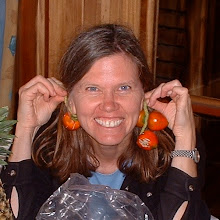My stitching activities have been dominated for the last few weeks by a temari project much bigger and more elaborate than anything I have tried before. I'm taking an on-line class taught by Barbara Suess on how to make her Grandmother Star ball. The ball is really huge—the diameter is over 5"/13cm. Even holding it to wrap the ball was a bit challenging, in spite of my long fingers. I made the ball's core out of coffee husks so it's a hefty ball but it has a very nice slightly soft feel. As part of the preparation steps, I also had to master making a really good C10 division and then further divide it to have 32 centers.
Fortunately, this challenge was broken into five weeks of lessons. Each week we could download very clear instructions as well as watch a video of Barb showing us what to do. The lessons were extremely detailed and clear, but in case of questions we could ask questions in a Yahoo group for our class. Here's my ball after finishing week 3 of the class.
Besides the grandmother star Ball, each week's class had another design that we could do on the off chance we didn't already have enough stitching to do. I found it useful to take a break from my big ball and do something a little smaller and easier. I stitched another pattern by Barb called Maritime Stars which can be purchased separately from her web site. I love those swirls and they aren't nearly as hard to do as they look. Of course, with my congenital inability to follow directions, I chose radically different colors. I'm pleased with the very sunny quality of my orange and yellow version.
This week I've been stitching all the tiny stars on the big ball. (There are 32 of them.) I've now stitched enough that I could take a picture showing what it would like when finished. What you can't see in this picture is that the back side doesn't have any stars. I've put a temari of the size I usually make next to it to give an idea of scale.
When I got tired of stitching those many small stars, I did one of the other patterns included in the course, which was relatively fast and easy. It's called Open Stars.
Only 18 more little stars to go—and I'm planning to do them gradually as the mood strikes me, in between working on other projects. I like how quick many temaris can be done since that gives me a chance to fool around with more colors and designs but it has been a fun accomplishment to learn how to make this ball.
Fortunately, this challenge was broken into five weeks of lessons. Each week we could download very clear instructions as well as watch a video of Barb showing us what to do. The lessons were extremely detailed and clear, but in case of questions we could ask questions in a Yahoo group for our class. Here's my ball after finishing week 3 of the class.
Besides the grandmother star Ball, each week's class had another design that we could do on the off chance we didn't already have enough stitching to do. I found it useful to take a break from my big ball and do something a little smaller and easier. I stitched another pattern by Barb called Maritime Stars which can be purchased separately from her web site. I love those swirls and they aren't nearly as hard to do as they look. Of course, with my congenital inability to follow directions, I chose radically different colors. I'm pleased with the very sunny quality of my orange and yellow version.
This week I've been stitching all the tiny stars on the big ball. (There are 32 of them.) I've now stitched enough that I could take a picture showing what it would like when finished. What you can't see in this picture is that the back side doesn't have any stars. I've put a temari of the size I usually make next to it to give an idea of scale.
When I got tired of stitching those many small stars, I did one of the other patterns included in the course, which was relatively fast and easy. It's called Open Stars.
Only 18 more little stars to go—and I'm planning to do them gradually as the mood strikes me, in between working on other projects. I like how quick many temaris can be done since that gives me a chance to fool around with more colors and designs but it has been a fun accomplishment to learn how to make this ball.





















